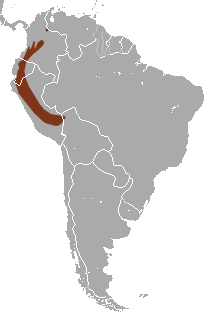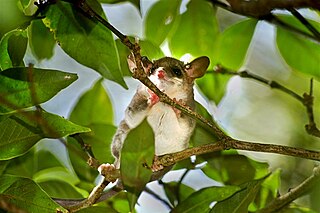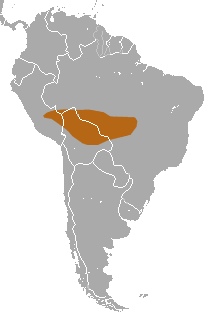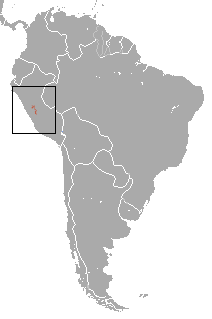
Opossums are members of the marsupial order Didelphimorphia endemic to the Americas. The largest order of marsupials in the Western Hemisphere, it comprises 126 species in 18 genera. Opossums originated in South America and entered North America in the Great American Interchange following the connection of North and South America.

The bare-tailed woolly mouse opossum or short-furred woolly mouse opossum is a South American marsupial of the family Didelphidae. Its range includes Brazil, Colombia, Ecuador, Peru, and Bolivia. It is found in tropical rainforest in the westernmost portion of the Amazon Basin and the eastern foothills of the Andes, at elevations up to 1634 m. It was formerly assigned to the genus Micoureus, which was made a subgenus of Marmosa in 2009.

The delicate slender opossum is a small pouchless marsupial of the family Didelphidae that occurs in French Guiana, Guyana, Suriname, and adjacent Venezuela and Brazil. Marmosops pinheiroi, Marmosops bishopi and Marmosops juninensis had long been considered to represent the same species, until parvidens and pinheiroi were found in sympatry in French Guiana. This species is found in moist primary tropical rainforest at elevations up to 2000 m. It is nocturnal and partially arboreal, and feeds on insects and fruit.

The rufous mouse opossum or little rufous mouse opossum is an opossum species from South America. The species has been found in Bolivia, French Guinea, Brazil, Colombia, Ecuador, Guyana, Peru and Suriname in lowland tropical rainforest at altitudes from 100 to 1000 m. It is presumed to feed on insects and fruit, like its close relatives.

Tschudi's slender opossum is an opossum species from South America, named after Swiss naturalist Johann Jakob von Tschudi. It is found in Bolivia, Brazil, Colombia, Ecuador, Paraguay, Peru and Venezuela.

The gray slender opossum, is an opossum species endemic to eastern Brazil.

The neblina slender opossum is an opossum species from South America. It is found in Brazil, Ecuador, Venezuela, and perhaps Peru.

The Brazilian slender opossum is an opossum species from South America. It is found in moist montane forest in the Atlantic Forest region of southeastern Brazil, including the states of Minas Gerais, Rio de Janeiro, São Paulo and Paraná. Its breeding may be fully semelparous, which is unusual for a mammal.

Pinheiro's slender opossum is an opossum species from South America. It is found in Brazil, French Guiana, Guyana, Suriname and Venezuela.

Marmosops is a genus of Neotropical opossums of the family Didelphidae. The genus was originally treated as a subgenus from the genus Marmosa rather than having their own classification. This was changed in 1989 by Gardner and Crieghton, who officially separated the group and made them their own genus. The mix-up between to genera Marmosa and Marmosops was common due to the similar appearances including size and other external features. However, the two groups differ significantly in their integument and in the arrangement of their skull and dentition. The dentition is similar in morphology between the two groups, with the exception of the deciduous lower third premolar varying from one genus to the next. The similarity between the two continues to cause the genus Marmosops to be frequently misidentified due to the lack of knowledge regarding the species along with the overlooked traits that help separate them from other opossums. The Marmosops are also commonly confused with the genus Gracilinanus, but this is quickly ruled out by a large number of differing characteristics. These differences include the arrangement of their digits, caudal scales, and the central hair on the scales changing from a three hairs per follicle to many more. This causes the hair of the Gracilinanus to be thicker and has also found to be heavily pigmented. The last group commonly confused with Marmosops is known as the genus Thylamys. These animals have a contrasting dorsal body pelage and the taxa are actually quite different.

The Aceramarca gracile opossum or Bolivian gracile opossum is a species of opossum. It is native to Bolivia and Peru, where it occurs in tropical elfin forest habitat.

The narrow-headed slender opossum is a species of opossum in the family Didelphidae. It is endemic to Venezuela.

Dorothy's slender opossum is a species of opossum in the family Didelphidae. It is found in Brazil and Bolivia. It is threatened by habitat loss.

Osgood's short-tailed opossum is a species of opossum in the family Didelphidae. It is found in Bolivia and Peru. Its natural habitats are subtropical or tropical moist lowland forest and subtropical or tropical dry lowland grassland. It is threatened by habitat loss. The opossum is named after American zoologist W. H. Osgood.

The Andean white-eared opossum is an opossum species from South America. It is found in the Andes Mountains, ranging from Venezuela to Bolivia.

Bishop's slender opossum is a small, arboreal marsupial opossum native to Brazil, Peru, and Bolivia. It somewhat resembles a placental rat or shrew.

Creighton's slender opossum, also known commonly as Voss' slender opossum is a species of South American opossum of the family Didelphidae. It is known only from the valley of the Rio Zongo in La Paz Department, Bolivia, where it lives in Andean cloud forests at elevations between 1800 and 3000 m. It was named after G. Ken Creighton by fellow American zoologist Robert S. Voss.

The Junin slender opossum is a species of South American opossum in the family Didelphidae. It is known only from the valley of the Chanchamayu in Peru where it lives in Andean montane forests at elevations between 1460 and 2200 m. The species is threatened by destruction of its forest habitat as the area under cultivation in the region increases.
The spectacled slender opossum, also known as little spotted slender opossum is a species in the marsupial genus Marmosops from South America.



















